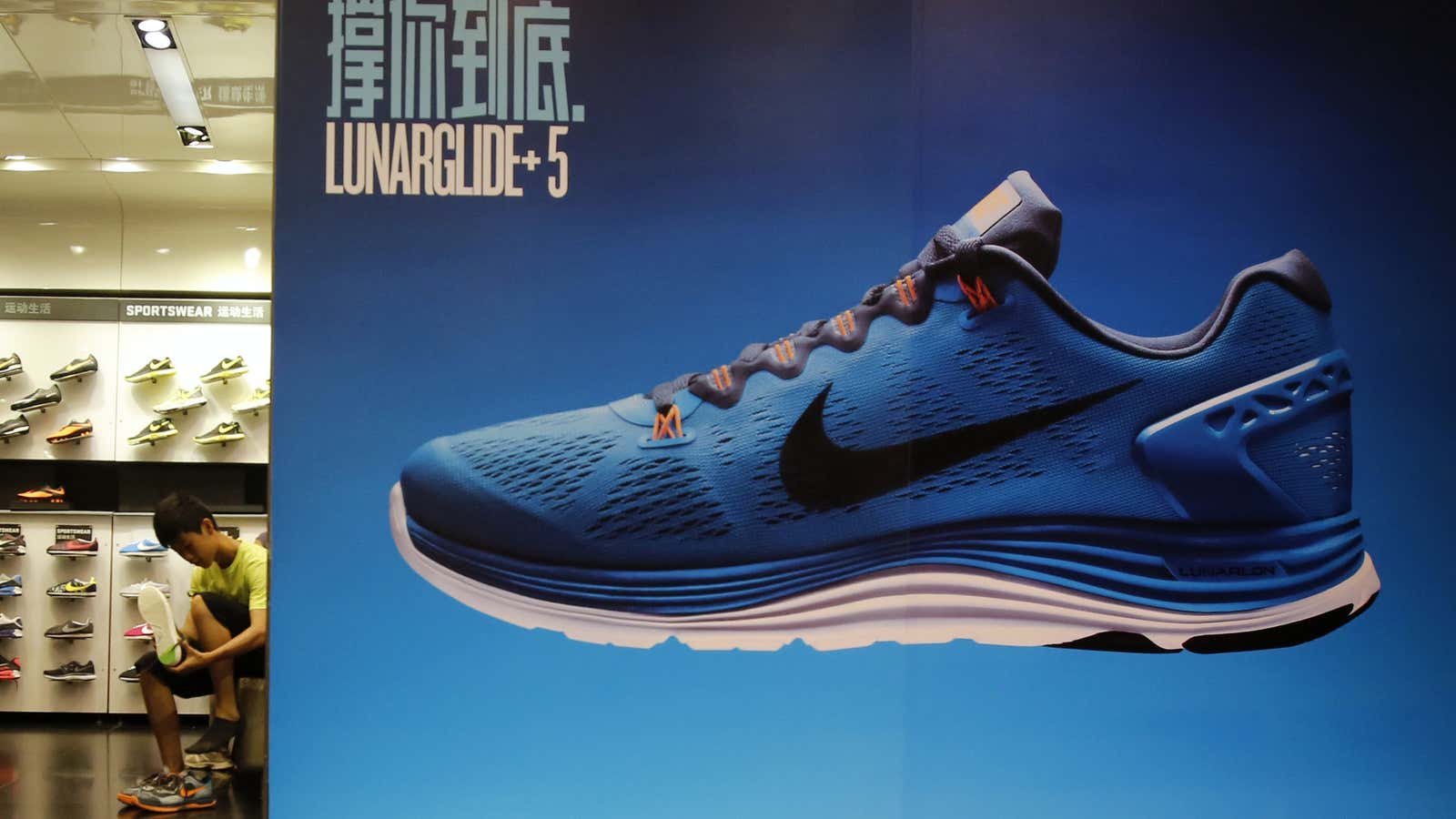If the world’s big sportswear brands could invent a country with just the right mix of ingredients to fuel their businesses for years to come, it would look a lot like present-day China.
To athletic wear companies including Nike, Adidas, New Balance, and Under Armour, as well as activewear brands such as Lululemon, what China offers is a perfect mix of factors: 415 million millennials; a booming middle class getting interested in health and fitness; government investment in sports; and a rapidly growing consumer appetite for sportswear—especially foreign brands.
The US is still unrivaled as the biggest market for sportswear, and won’t cede the title anytime soon. But it’s a mature and fiercely competitive market, much like Western Europe. In China, the rising tide is lifting all boats, even with increasing competition in the country’s sportswear sector. And brands have been cashing in. Nike, for instance, recorded growth of about 9.5% (pdf) last quarter in China. Adidas saw its sales jump 22% (pdf) in the country through 2016.
This is just the start, these brands say. ”We believe we’ve just scratched the surface of our growth potential in this important market,” said Mark Parker, CEO of Nike—already the top brand in the country—on a call with investors March 21.
“In China the opportunity is massive,” Nike brand president Trevor Edwards told investors.
Here’s a closer look at some of the factors that have sports brands drooling over China:
Demographics
China has 415 million millennials, according to a 2015 report (pdf) by Goldman Sachs—exceeding the 350 million or so people who make up the entire working populations of the US and Western Europe combined.
China already has the world’s largest middle class, and it’s still growing. Goldman Sachs estimates that the country’s aggregate income will grow by around $3 trillion in the next decade.
Sports participation
China’s millennial generation is very different from the one that preceded it. It’s more globally connected because of technology, and it has a strong consumer appetite, matched by rising purchasing power. Economic development is bringing with it an interest in new activities, especially sports.
Higher incomes, beyond just resulting in more discretionary spending, tend to lead to greater rates of participation in leisure activities and sports, as Morgan Stanley noted in a 2015 note to investors. Already gym membership in China has doubled since 2008, according to figures from China Business Research Academy reported by (paywall) the Financial Times. And the number of marathons taking place in the country has grown sixfold over the past five years, Nike noted on its call.
Government investment
In a bid to become a global soccer superpower, China’s government has vowed to have more than 70,000 soccer pitches ready across the country by 2020, an increase of about 20,000 from its 2013 total. To help accomplish the goal, Chinese president Xi Jinping announced plans to expand the country’s “sport economy” to $850 billion by 2025, which would make it the world’s largest.
The Chinese government’s push for sports isn’t just about bragging rights. To counter rising rates of health problems such as obesity and diabetes, it has also urged citizens to be more physically active. The country launched a national fitness plan through 2020 that will involve significant investment in sport and fitness facilities.
Together these projects are creating the conditions for a more active society, and active people require activewear.
Appetite for activewear
Sportswear is currently carrying the global apparel industry, and China is no exception. Last year, sales of sportswear jumped 11% in China, according to research firm Euromonitor, while overall apparel sales rose just 5%.
Like countless shoppers around the US and Europe, Chinese consumers are developing a taste for activewear as everyday clothing. “They want a versatile piece of footwear, or they want apparel they can do sports in but also go to social occasions in,” Colin Currie, Adidas’s managing director for Greater China told CNBC. “You know in lower-tier cities, it’s okay to go to a wedding or to work in Adidas.”
As sportswear leans further toward fashion, wealthy Chinese are buying it up, sometimes at the expense of luxury labels. Euromonitor estimates that China’s market for sportswear will surpass that for luxury goods by 2020.
Mid-market brands, such as China’s homegrown sports label Anta, could be the biggest beneficiaries of the new Chinese athleticism, since foreign brands such as Adidas and Nike are seen as fashion products as much as fitness ones. But Chinese shoppers also want the brand prestige and perceived quality of foreign labels, which gives companies such as Nike and Adidas an advantage over domestic rivals. Those two companies are actually China’s top sportswear brands by market share.
The companies are understandably cautious of their reputations. Nike recently found itself scrambling when Chinese state TV accused it of false advertising, forcing Nike to admit it had sold 300 pairs of Hyperdunk sneakers in China that had “an inaccurate product description stating that the shoe contained airbags,” according to a statement from the brand. It apologized and offered compensation to the understandably disappointed purchasers of the shoes.
The flub is the sort of thing Nike doesn’t want to repeat. It has the lead in China for now, but Adidas has been putting the pressure on and nailing the fashion aspect of sportswear. There’s a lot of money on the table in China, and everyone is going to be fighting for a share.
